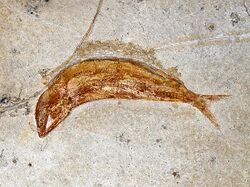Biology:Leptolepis
| Leptolepis | |
|---|---|

| |
| Leptolepis knorri, from Solnhofen (Germany). Jurassic | |
| Scientific classification | |
| Domain: | Eukaryota |
| Kingdom: | Animalia |
| Phylum: | Chordata |
| Class: | Actinopterygii |
| Order: | †Leptolepiformes |
| Family: | †Leptolepidae |
| Genus: | †Leptolepis Agassiz, 1843 |
| Type species | |
| Cyprinus coryphaenoides | |
Leptolepis ("delicate scale") is an extinct genus of teleost fish that lived in freshwater and marine environments from the Middle Triassic period until the Early Cretaceous. The genus is one of the earliest recognized teleost genera.
Species
- Leptolepis africana Gardiner 1960
- Leptolepis autissiodorensis Sauvage 1892
- Leptolepis brodiei Agassiz 1845
- Leptolepis concentricus Egerton 1849
- Leptolepis coryphaenoides Bronn 1830
- Leptolepis disjectus Woodward 1890
- Leptolepis gregarius Woodward 1895
- Leptolepis jaegeri Agassiz 1844
- Leptolepis knorri Agassiz[2]
- Leptolepis lowei Woodward 1895
- Leptolepis macrophthalmus Egerton 1853
- Leptolepis neumayri Agassiz, L., 1832[3]
- Leptolepis nevadensis David 1941
- Leptolepis normandica Nybelin 1962
- Leptolepis saltviciensis Simpson 1884
- Leptolepis toyei Flannery Sutherland et al. 2017[4]
- Leptolepis wealdensis Flannery Sutherland et al. 2017[4]
Species formerly placed in Leptolepis
- Leptolepis talbragarensis Woodward 1895 (Now referred to Cavenderichthys)
- Leptolepis koonwarri Waldman 1971 (Now referred to Waldmanichthys)[5]
Fossil record
As mentioned earlier, fossils of Leptolepis are found in freshwater and marine strata from the Middle Triassic until the Cretaceous (age range: from 242.0 to 112.6 million years ago.). Fossils are known from several localities in Eurasia, North America, Africa and Australia .[1]
Appearance
An average individual of Leptolepis was about 30 centimetres (12 in) long, and superficially resembled the unrelated modern herring. It was the first true bony fish to really live up to the name, possessing a skeleton completely made of bone;[6] some previous genera such as Pholidophorus had skeletons composed of bone and cartilage. Another modern development in Leptolepis were its scales, which lacked the covering still present in previous genera. These two developments made swimming easier, as the bony spine was now more resistant to the pressure caused by the S movements made while swimming.[7]
Mass graves of Leptolepis have indicated that species probably lived in schools which would provide some protection from predators while the creatures fed on surface plankton. Pelagosaurus was a known predator of Leptolepis, as a Pelagosaurus fossil was found with Leptolepis remains in its stomach.[8]
The Morrison cf. Leptolepis
Known only from a single nearly complete skeleton found at Rabbit Valley, Colorado.[9] A 13 centimetres (5 in) fish that was deeper bodied than its co-occurring contemporaries Morrolepis and Hulettia.[9] The Morrison cf. Leptolepis probably had a live mass of about 37 grams (1.3 oz).[9] It is the only teleost fish known from the formation and was morphologically more highly derived than other Morrison fish.[9] A specific example of apomorphy in cf. Leptolepis is its "more modern tail structure" compared to Morrolepis.[9] It is believed to have fed on fish and small invertebrates.[9]
Bibliography
- Silva Santos, R. (1958) - Leptolepis diasii, novo peixe fossil da Serra do Araripe, Brasil”. Boletim da Divisa˜o de Geologia e Mineralogia do Departamento Nacional de Produc¸a˜o Mineral, Notas Preliminares, Brazil 108, 1–15. o, Kiadó: Departamento Nacional de Produc¸a˜o Mineral.
- Maisey, J.. Santana fossils, an illustrated atlas. Neptune City, New Jersey, USA: T.F.H. Publications (1991)
- Silva Santos, R. (1995) - Santanichthys, novo epı´teto gene´rico para Leptolepis diasii Silva Santos, 1958 (Pisces, Teleostei) da Formac¸a˜o Santana (Aptiano), Bacia do Araripe, NE do Brasil”. Anais da Academia Brasileira de Cieˆncias, Brazil 67, 249-258. o, Kiadó: Academia Brasileira de Cieˆncias.
- Filleul, Arnaud, John G. Maisey (2004) - Redescription of Santanichthys diasii (Otophysi, Characiformes) from the Albian of the Santana Formation and Comments on Its Implications for Otophysan Relationships”. American Museum Novitates, New York, NY, USA 3455, American Museum of Natural History
References
- ↑ 1.0 1.1 1.2 Fossilworks
- ↑ GBIF
- ↑ Biolib
- ↑ 4.0 4.1 Joseph T. Flannery Sutherland; Peter A. Austen; Christopher J. Duffin; Michael J. Benton (2017). "Leptolepid otoliths from the Hauterivian (Lower Cretaceous) Lower Weald Clay (southern England)". Proceedings of the Geologists' Association 128 (4): 613–625. doi:10.1016/j.pgeola.2017.05.001. https://research-information.bristol.ac.uk/en/publications/leptolepid-otoliths-from-the-hauterivian-lower-cretaceous-lower-weald-clay-southern-england(cdb6c340-050c-4470-a2f4-da42b80298c1).html.
- ↑ Sferco, Emilia, Adriana López-Arbarello, and Ana María Báez. "Phylogenetic relationships of† Luisiella feruglioi (Bordas) and the recognition of a new clade of freshwater teleosts from the Jurassic of Gondwana." BMC Evolutionary Biology 15.1 (2015): 1.
- ↑ The virtual petrified wood museum
- ↑ Palmer, D., ed (1999). The Marshall Illustrated Encyclopedia of Dinosaurs and Prehistoric Animals. London: Marshall Editions. p. 39. ISBN 1-84028-152-9.
- ↑ Pierce, Stephanie E.; Benton, Michael J. (2006). "Pelagosaurus typus Bronn, 1841 (Mesoeucrocodylia: Thalattosuchia) from the Upper Lias (Toarcian, Lower Jurassic) of Somerset, England". Journal of Vertebrate Paleontology 26 (3): 621–635. doi:10.1671/0272-4634(2006)26[621:PTBMTF2.0.CO;2].
- ↑ 9.0 9.1 9.2 9.3 9.4 9.5 Foster, J. (2007). "cf. Leptolepis." Jurassic West: The Dinosaurs of the Morrison Formation and Their World. Indiana University Press. p. 135.
Wikidata ☰ Q839380 entry
 |

